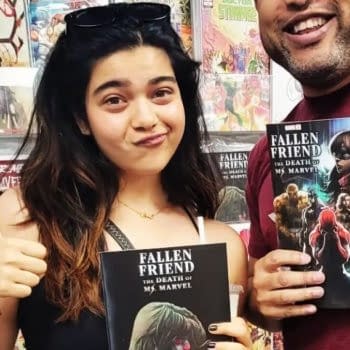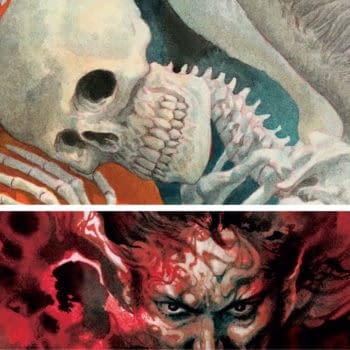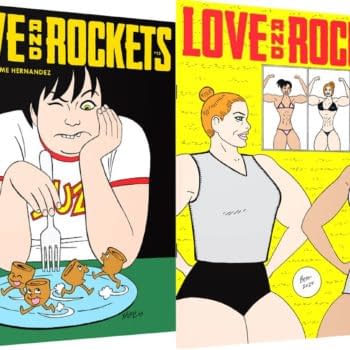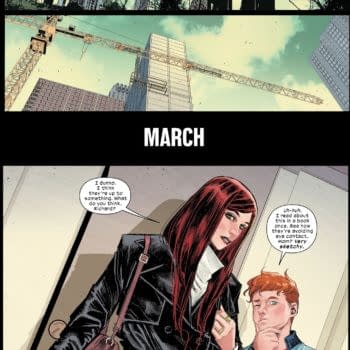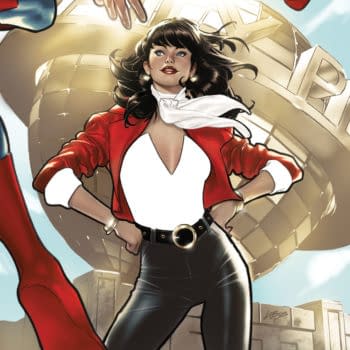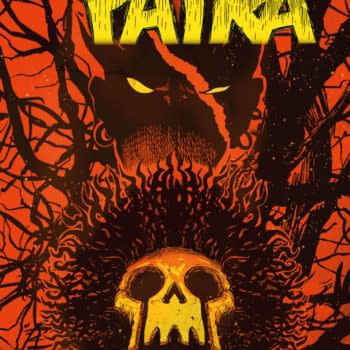Posted in: Comics, Recent Updates, san diego comic con | Tagged: Comics, dark horse comics, dave mckean, dc comics, entertainment, filmmaking, luna, neil gaiman, Pictures That Tick Volume 2, sandman
The 'Slipstream World' Of Pictures That Tick Vol. 2 – Dave McKean In The Bleeding Cool Interview At San Diego Comic Con
Dave McKean has changed the way we see comics, filmmaking, and multi-media projects with his unique personal vision of storytelling, and continues to do so, challenging the prevailing assumption that comics, for one, should mainly be comprised of drawing, inking, and coloring. His haunting covers for Sandman, as well as his new covers for Sandman: Overture push the boundaries on comic cover art, and his graphic novels with Neil Gaiman including Violent Cases and Mr. Punch, as well as his self-written and illustrated graphic novel Cages continue to influence the direction of visual narrative. His newly collected volume: Pictures That Tick: Volume 2 "Short Narrative Exhibition" arrived from Dark Horse in July and is currently available in a limited, signed hardback edition and in large-format paperback.
Fresh from the news that his film Luna was complete and awaiting its premier, McKean made some time to talk with me at San Diego Comic Con about the new collection, his working methods, and upcoming works, including a new book from DC entitled Dream State: The Collected Dreaming Covers that includes many of his covers for Sandman-related works as well as an all-new collaboration between McKean and Gaiman, coming this autumn.
HMS: You have a new volume of Pictures That Tick that's just come out from Dark Horse. It's been a few years since the last volume came out and it's shorter pieces that are collected. I'm wondering if, when you look at Volume 2, you see things that might have changed in your own artwork or in your own development?
Dave McKean: Well, actually, the first volume, when it came out, as a hardback, it was about 10 years ago, so I'm continuing to experiment with comics. I still love comics as a medium. I'm not so keen on the business side of it, and I'm not so keen on the mainstream side of it, but I just love the medium. So, I've always done comics just for myself or for other projects, and it's nice just to see them all in one place. And I'm just trying to keep pushing those barriers out. It felt like when I started in the 80's, that was what my little gang were all trying to do, and it seems to have all rather eased off a bit. It seems to have become rather safe in these last 10 or so years, so I'm still keen to try to push the boundaries back.
HMS: So the works that appear in Pictures That Tick Volume 2 have appeared elsewhere, in galleries and things?
DMcK: Some of them have. This book is subtitled "Exhibitions" simply because several of the stories were set up in rooms that you could explore and you could find the story for yourself. One of them is quite linear, so you can read it along the walls of the gallery, but a couple of others you had to work at a bit and they were much more interactive. So the book is a reduced version of that experience, because it is a book. But I think you get the gist of it and it gives a feel for what the original was like.
HMS: I recall last year at San Diego Comic Con, you talked about some of those projects that have now appeared in the book.
DMcK: Yes, all of those things. I've been talking about them for a few years, since they keep coming up. There's one called The Blue Tree and there's one called The Rut and they've all finally appeared in this volume.
HMS: These are shorter pieces, but they come from these wider experiences. Do you find a benefit or a special outlet in shorter pieces rather than the long form? Cages, of course, is an example of a much longer project.
DMcK: A lot of them are quite personal stories and they very often are just based on one event or one quite strong emotional thing that happened or occurred to me. And so that's quite nice to alight on that and just really work it out as a short story. It doesn't really warrant becoming some big elaborate long book or a film or something like that, but the intensity of a little short story, when you deal with it, it's the perfect form really.
And it also means that stylistically, in a longer story you tend to need a style that is more consistent and it draws you into that world, and you can tell that story over a longer book, 400 or 500 pages or whatever. But for a shorter story, I can work in any medium because it's short and intense and I don't have to sustain it so much.
HMS: When you look at the volume, collected and put together, and presumably you designed the order and where the stories are placed, do you see commonalities that lead through in the order that you've chosen?
DMcK: I did design it, yes. Well, they all exist in a certain kind of slipstream world between a regular, kitchen sink, everyday, contemporary, modern world you would recognize and this sort of fantastical, dream-like filtered version of the same thing and I think that one intensifies the other. If it was just dreamy fantasy stories without the grit of reality behind them, I think they would be rather pointless and indulgent. And I think if they were just plain kitchen sink drama narratives, I don't think they would really warrant such treatment or really need telling. They are everyday things to most people. They are about having kids, raising kids, being a Dad, trying to do creative things, you know all of those things that are sort of rather mundane things, but they are important. But when something happens that I think is really important, like you observe something about your children or you observe something about yourself, to see that observation through the lens of imaginative imagery and my dream life or my imaginative life, it seems to become more resonant really, something in which other people can see those things anew. If you just say, anecdotally, "By the way, have you noticed this?", it's a bit of a throwaway, but if you can phrase it in some sort of way that can make it more poetic or resonant, it seems to stick, to have more resonance.
HMS: Ironically, that's what seems to make it more universal…
DMcK: Absolutely.
HMS: …rather than simply presenting events that might be recognizable.
DMcK: And the language of the imagery is quite personal and it's quite mine, but you're right, it does seem to become more symbolic and more empathic, something that other people can key into.
HMS: When we are looking at this particular book, what kind of media are we seeing behind these works? Speaking literally, what are the tools and the items you've used to make these stories?
DMcK: They are all sorts, and again that's the lovely thing about these short stories, I can play. So there are drawings and paintings and comic book pages that you would recognize as comic book pages, but there are also photographs and sculptures, and whole rooms that are stories. There are the simplest of line drawings and very, very, very complicated paintings and collages and puppet shows. It's a beautiful medium and it doesn't have to be this one kind of drawing that has dominated the medium so much. And there's nothing wrong with that, but it doesn't have to be that. It can be other things as well.
HMS: Sidebar—I saw a comic recently that was just a creator-owned thing, self-published, and it was entirely sculpture in still-shots. I was so impressed by the work that went into that. I know it took a long time.
DMcK: Yes, absolutely. And there's no reason it shouldn't be that.
HMS: Can you give some top media elements you like to use to make things?
DMcK: My favorite is always the next thing. It's not really a specific thing, but the thing that I haven't tried yet, or the use of that medium that I haven't tried yet. I still really love just drawing. There's something really beautiful and pure about sitting down, blank piece of paper, a pen or a pencil, and just drawing something. So, I think I'll always love that. And I did a lot of work with computers when they first became useable. I bought my first Mac and Photoshop in 1993, I think. It is a tremendously powerful tool. I don't really use it so much anymore for creating the basic images, but still for compositing and designing the book, and bringing everything together and getting it right. It's wonderfully powerful.
HMS: Do you use that for adding layers? I know many artists find computers useful for doing that.
DMcK: The layers are useful. But just the accuracy and all those little things that you would live with in a painting or a drawing in the past, I can just get them right. It's a slightly compulsive disorder quality, I think, but it's just nice to be able to get these things right. It means looking through the book right now, nothing stings. Whereas most of my early books, if I look at them at all, because they are hard to look at, very often the images just really hurt me. (laughter)
HMS: Well, what this means is that every image is essentially able to be a Director's Cut now.
DMcK: It does feel like that. It does feel like you can just get it right. You can get the storytelling right, the grading right. I've learned a lot from film grading, and I tend to apply those rules and ideas to comics and everything I do. The grade of it, meaning the modulation of the density of the tones and also the color, across the whole thing. It adds so much. There's so much of the atmosphere and everything that is in that, so it's lovely to be able to get it right.
HMS: That kind of segues into another area, the films you've been working on. Would you like to tell us about them? I hear that Luna's done?
DMcK: Luna's finished. After 6 years. No reason why it should have taken 6 years. It's just 4 actors in a house and a few odd fantasy sequences. I'm happy that it's done. I'm happy with it. I like it. And we are now building a life for it. We have a World Premier set up, and a UK Premier, so we'll take it from there.
HMS: How far off is that, do you know?
DMcK: The thing is it's not been officially released, that information, but it's soon [*A couple of days later the Premier of Luna was announced for the Toronto Film Festival in September]. Very soon.
HMS: And people can follow the Facebook page, and hear more about that, where they can see the trailer and the like.
DMcK: And I'll be sharing the trailer here in a panel at San Diego Comic Con.
HMS: I'll squeeze in a couple more questions: What is a day like for you? I know that's going to change depending on your projects.
DMcK: Too short.
HMS: How do you decide which project of many to work on during a particular day?
DMcK: I tend to like to have a few going. So I've got a couple of comics projects going, and I've got a film project going. And some musical, more theater-related things going. And it just means that whatever I feel like doing that day or that week, I can really get excited about it and do it, and it doesn't become a drag. Because it's actually being able to vary these things that keeps everything a bit fresh.
HMS: Yes, so you never feel like you're chaining yourself to a desk and forcing yourself to work just on one thing?
DMcK: No. The comics that I'm doing are long, and they'll be 300 or 400 pages long, and they just take a long time. And I'd rather them take a bit longer, but stay fresh doing it than just literally do it day in and day out. And I know that some people can do it, and that's their rhythm, and that's their method, but I just can't do it.
HMS: Well, I think that's what creators are often told to do, or told by others that they have to do to be successful and complete projects, but that's not always the case.
DMcK: Yes, it becomes a real treadmill. And I can feel the drawings becoming stale. It's much better to take a break and come back to the project fresh. The books take longer to come out, but they are better in the end, I think.
HMS: As they say, if you can't live with it, or sleep on it, why do it?
DMcK: Yes, you only get to do these things once, so I want it to be the best it can be.
HMS: Any upcoming projects you'd like to talk about aside from the release of Luna?
DMcK: The next thing would probably be that I'm getting back to working on a graphic novel that I started a long time ago and I put it aside for various reasons. It's going to come out from Abrams. It's called Caligaro and it's based on, and is a reworking of The Cabinet of Doctor Caligari.
Of course, I've also done a bunch of work for DC. New editions of my old books, but there's also a new book called Dream State, which collects all The Dreaming covers and Sandman: Overture covers, Sandman Presents, and all the various Sandman-y things. Plus there are a bunch of personal drawings in there as well, and a new little story that Neil [Gaiman] wrote that I've illustrated. So that's timed, I think, for November. And I'm really happy with it. I pitched them doing that book years ago, and for some reason, they weren't interested. But they jumped at it this time.
HMS: Wow! That kind of goes along with the previous collection of covers, the Dustcovers book.
DMcK: Yes, I've done a new cover for the new edition of that. Otherwise it's unchanged, but I've done a digital clean-up and Director's Cut version of Mr. Punch and that's out as well. And then a 25th Anniversary Edition of Arkham Asylum. So they'll all come out at the end of the year. And I'm 50, so it's the right year to be doing all this. (laughs) Revisiting things.
Here's the trailer for the soon to be premiering film Luna:
[vimeo]http://vimeo.com/100979394[/vimeo]
And here are a few images from my limited edition Pictures That Tick Vol. 2 which I couldn't resist picking up at San Diego Comic Con this year:

























